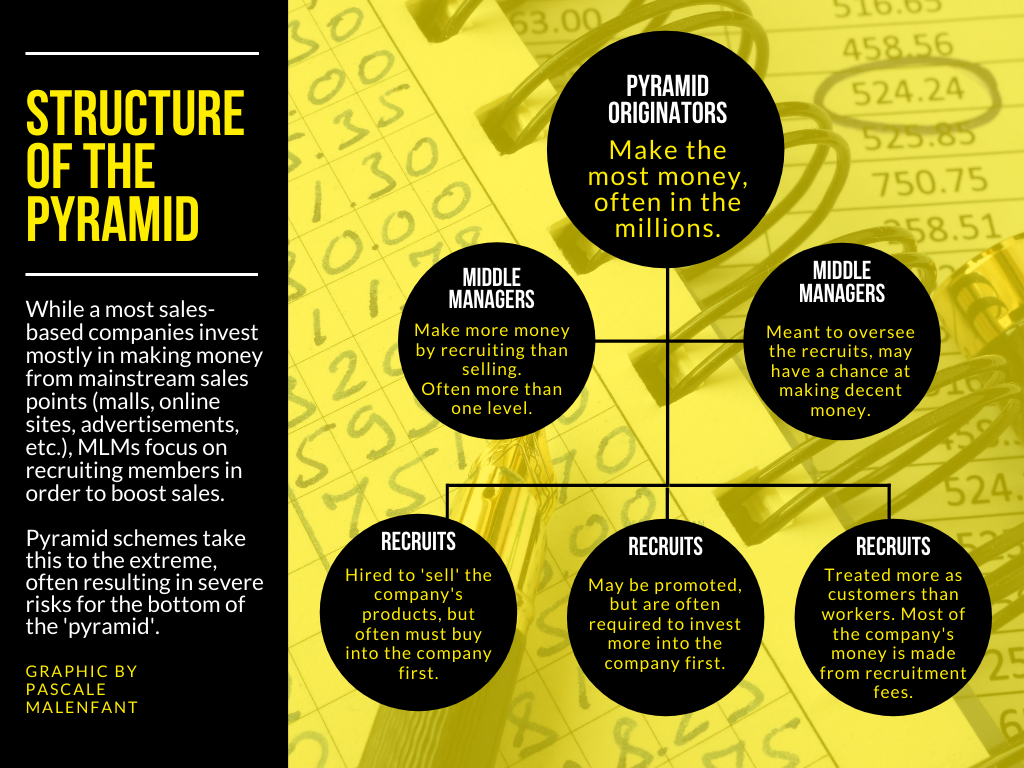It seems that almost every time we start a YouTube video, we are bombarded with advertisements that show people telling us to drop out of college for some kind of get-rich-quick scheme.
Internet gurus like Tai Lopez all suspiciously started out the same way: they were broke and thousands of dollars in debt from a “useless” post-secondary degree. All of a sudden, they started making thousands of dollars a month and are supposedly living the dream.
Of course, people in similar situations begin to wonder how these supposed business prodigies do all this, gravitating to them and their (paid) online classes where they allegedly teach the tricks one needs to start making money in the simplest way possible.
This ‘simple way’ of making money is often nothing other than multi level-marketing, otherwise known as MLM. But what is MLM, and is it actually a legitimate way to do business?
MLM is a strategy that involves people selling products to a targeted demographic of consumers outside of a retail environment. They are legal businesses with hierarchical structures (see the graphic below), and while many MLMs are completely genuine for both consumers and workers, they can easily be corrupted.
When an MLM goes rogue and operates illegally (or simply unethically), it’s often referred to as a pyramid scheme.
Both function very similarly in terms of work and service—the reputations of which have rendered them controversial, often turning people off from participating.
MLMs operate by selling their products to consumers through either direct sales or word of mouth. They target consumers both conventionally (through direct sales in stores or online) and less conventionally (having salespeople share their merchandise and experiences with the company on social media, via email, etc.).
Contrary to popular belief, it is possible to be part of an MLM and make legit money from it. However, the best way to tell if an MLM is more of a pyramid scheme is by abiding by the age-old saying, ‘If it seems too good to be true, then it probably is.’
Unfortunately for those who become interested in this type of business, it is very easy to fall for illegal scammers and lose all the money you’re putting in with no return. If the company has a low quality product or service and yet seems to have rave reviews on select sites, it’s probably not above-board.

In a pyramid scheme, there really is no product being sold to regular consumers—at least, whatever product the company is selling isn’t where it’s making the majority of its money.
Rather, they make their money by having “recruits”—or bottom-level employees hired under the guise of selling their products—to invest in the company. This can mean having recruits act as social media ambassadors by purchasing the company’s products to then review them online, or simply having them pay regular membership fees in order to remain part of the pyramid.
Social media seems to be the most popular medium for MLMs’ and pyramid schemes’ recruitment strategies nowadays, so much so that it is often difficult to distinguish legitimate reviews and thoughts on products from MLM promotion.
A very popular type of pyramid scheme that is starting to surface and all around social media, especially Instagram, is Forex—short for foreign exchange market.
Essentially, Forex involves buying different countries’ currencies, then selling it based on supply and demand of the market. Forex traders rarely work independently. Instead, they work for multi-level Forex firms.
These so-called firms are everywhere on Instagram, associated with pictures of people holding stacks of cash, living the luxurious life, and recruiting with the promise of money and cars.
Most of these Forex firms are scams, as they often require new recruits to directly invest in the company’s pool of currency before they can begin trading for themselves.
Like most pyramid schemes, Forex trading relies on accumulating more and more ‘traders,’ convincing recruits they are ‘investing in themselves’ when buying into the company. What they’re really doing is putting their money into investment that will never get them a return, and if it does, it won’t be substantial.
Perhaps the underlying message is this: there really is no such thing as a real ‘get rich quick’ scheme. If you want to live a life of luxury and smooth sailing, then you can’t cut corners—you might just have to work hard, the proper way.
Featured graphic by Sara Mizannojehdehi.






